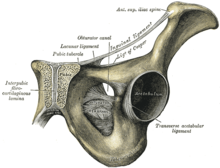Inguinal ligament
The inguinal ligament ( Latin for inguinal ligament ); Also called Vesalius band (after the Flemish anatomist Andreas Vesalius ) or Fallopio band (after the Italian anatomist and surgeon Fallopius ), is a connective tissue structure on the human pelvis . It connects the anterior upper iliac spine ( spina iliaca anterior superior ) of the iliac bone ( os ilium ) with the pubic tubercle of the pubic bone ( os pubis ) and thus delimits the space for the muscle and vascular portal ( lacuna musculorum and lacuna vasorum ). The inguinal ligament corresponds to the reinforcement of the aponeurosis of the Mm. obliquus externus abdominis , obliquus internus abdominis and transversus abdominis .
By attaching the band to the skin of the abdomen , the so-called inguinal furrow is created, which represents the central structure of the groin (inguinal area) that extends over the abdomen and thighs .
In domestic animals , the corresponding structure is called the arcus inguinalis (inguinal arch). It runs from the eminentia iliopubica to the hip hump ( tuber coxae ) and is formed from the aponeuroses of the oblique abdominal muscles and the fascia of this area.
literature
- G. Aumüller et al .: Anatomy. Dual series . Thieme, Stuttgart 2006, ISBN 978-3131360410

